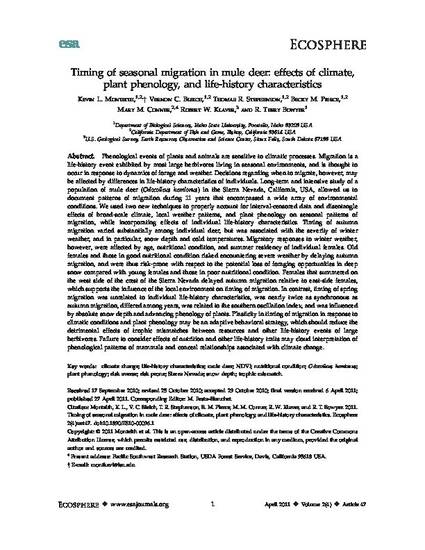
Article
Timing of seasonal migration in mule deer: effects of climate, plant phenology, and life-history characteristics
Ecosphere
(2011)
Abstract
Phenological events of plants and animals are sensitive to climatic processes. Migration is a
life-history event exhibited by most large herbivores living in seasonal environments, and is thought to
occur in response to dynamics of forage and weather. Decisions regarding when to migrate, however, may
be affected by differences in life-history characteristics of individuals. Long-term and intensive study of a
population of mule deer (Odocoileus hemionus) in the Sierra Nevada, California, USA, allowed us to
document patterns of migration during 11 years that encompassed a wide array of environmental
conditions. We used two new techniques to properly account for interval-censored data and disentangle
effects of broad-scale climate, local weather patterns, and plant phenology on seasonal patterns of
migration, while incorporating effects of individual life-history characteristics. Timing of autumn
migration varied substantially among individual deer, but was associated with the severity of winter
weather, and in particular, snow depth and cold temperatures. Migratory responses to winter weather,
however, were affected by age, nutritional condition, and summer residency of individual females. Old
females and those in good nutritional condition risked encountering severe weather by delaying autumn
migration, and were thus risk-prone with respect to the potential loss of foraging opportunities in deep
snow compared with young females and those in poor nutritional condition. Females that summered on
the west side of the crest of the Sierra Nevada delayed autumn migration relative to east-side females,
which supports the influence of the local environment on timing of migration. In contrast, timing of spring
migration was unrelated to individual life-history characteristics, was nearly twice as synchronous as
autumn migration, differed among years, was related to the southern oscillation index, and was influenced
by absolute snow depth and advancing phenology of plants. Plasticity in timing of migration in response to
climatic conditions and plant phenology may be an adaptive behavioral strategy, which should reduce the
detrimental effects of trophic mismatches between resources and other life-history events of large
herbivores. Failure to consider effects of nutrition and other life-history traits may cloud interpretation of
phenological patterns of mammals and conceal relationships associated with climate change.
Keywords
- climate change,
- life-history characteristics,
- mule deer,
- NDVI,
- nutritional condition,
- Odocoileus hemionus,
- plant phenology,
- risk averse,
- risk prone,
- Sierra Nevada,
- snow depth,
- trophic mismatch
Disciplines
Publication Date
April, 2011
DOI
10.1890/ES10-00096.1
Publisher Statement
Works produced by employees of the U.S. Government as part of their official duties are not copyrighted within the U.S. The content of this document is not copyrighted.
Citation Information
Kevin L. Monteith, Vernon C. Bleich, Thomas R. Stephenson, Becky M. Pierce, et al.. "Timing of seasonal migration in mule deer: effects of climate, plant phenology, and life-history characteristics" Ecosphere Vol. 2 Iss. 4 (2011) p. 47 Available at: http://works.bepress.com/robert-klaver/32/
